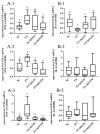Effects of Resveratrol on Muscle Inflammation, Energy Utilisation, and Exercise Performance in an Eccentric Contraction Exercise Mouse Model
- PMID: 36615906
- PMCID: PMC9824440
- DOI: 10.3390/nu15010249
Effects of Resveratrol on Muscle Inflammation, Energy Utilisation, and Exercise Performance in an Eccentric Contraction Exercise Mouse Model
Abstract
Eccentric contraction can easily cause muscle damage and an inflammatory response, which reduces the efficiency of muscle contraction. Resveratrol causes anti-inflammatory effects in muscles, accelerates muscle repair, and promotes exercise performance after contusion recovery. However, whether resveratrol provides the same benefits for sports injuries caused by eccentric contraction is unknown. Thus, we explored the effects of resveratrol on inflammation and energy metabolism. In this study, mice were divided into four groups: a control group, an exercise group (EX), an exercise with low-dose resveratrol group (EX + RES25), and an exercise with high-dose resveratrol group (EX + RES150). The results of an exhaustion test showed that the time before exhaustion of the EX + RES150 group was greater than that of the EX group. Tumour necrosis factor-α (Tnfα) mRNA expression was lower in the EX + RES150 group than in the EX group. The energy utilisation of the EX + RES150 group was greater than that of the EX + RES25 group in different muscles. High-dose resveratrol intervention decreased Tnfα mRNA expression and enhanced the mRNA expressions of sirtuin 1, glucose transporter 4, AMP-activated protein kinase α1, and AMP-activated protein kinase α2 in muscles. These results revealed that high-dose resveratrol supplementation can reduce inflammation and oxidation and improve energy utilisation during short-duration high-intensity exercise.
Keywords: anti-inflammation; downhill running; eccentric contraction; energy utilization; resveratrol.
Conflict of interest statement
The authors declare no conflict of interest. The funders had no role in the design of the study; in the collection, analyses, or interpretation of data; in the writing of the manuscript, or in the decision to publish the results.
Figures









References
MeSH terms
Substances
Grants and funding
LinkOut - more resources
Full Text Sources
Medical

